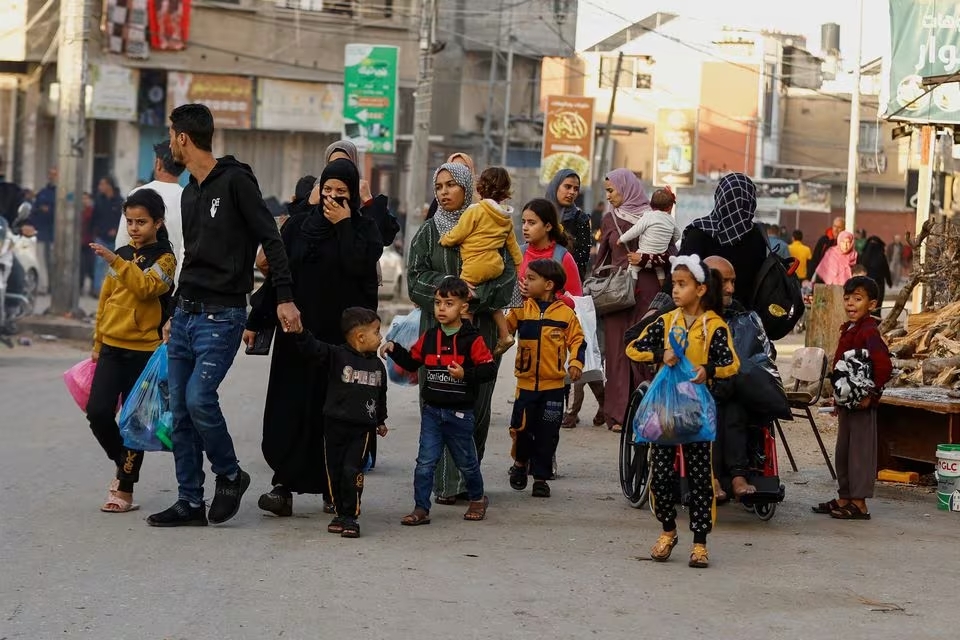After scores of Palestinians were killed on Thursday as they tried to get food and supplies from an aid convoy, the president said “the United States will do more.”

President Biden said on Friday that the United States would begin airdropping humanitarian relief supplies into Gaza, a decision prompted by the dozens of Palestinians who were killed as Israeli forces opened fire near an aid convoy in Gaza City a day earlier.
“Innocent people got caught in a terrible war unable to feed their families, and you saw the response when they tried to get aid in,” Mr. Biden said before meeting with Prime Minister Giorgia Meloni of Italy. “And we need to do more, and the United States will do more.”
Mr. Biden said that the United States would work with Jordan, which has been at the forefront of airdrop efforts to Gaza, as well as other allies to deliver aid by air and that supplies could, eventually, also be delivered by sea.
“Aid flowing to Gaza is nowhere nearly enough now,” Mr. Biden said. “Innocent lives are on the line, and children’s lives are on the line.”
Mr. Biden and Ms. Meloni discussed efforts to prevent the war in Gaza from becoming a larger conflict, as well as support for Ukraine and steps to address human trafficking and global migration.
John F. Kirby, a senior National Security Council official, said that the first airdrops would focus on food, followed by water and medicine. A U.S. military official said the Air Force plans to drop 50,000 meal rations.
The Biden administration has been considering airdrops for some time, but so far has chosen not to in part because of the logistical challenges of dropping aid into a dense war zone. But Mr. Kirby said that the chaos on Thursday had underscored the need to “find more creative ways of getting assistance in faster and at a greater scale.”
The deaths around the convoy have brought the humanitarian crisis in Gaza into a sharper focus for administration officials, they say. Officials have said they do not know what precisely happened at the convoy, but that they believe the disastrous events on Thursday show the lack of security in Gaza, throwing in sharp relief a failure of Israel’s war and the increasingly desperate situation for Palestinians there.
The deaths may prove to be something of an inflection point, prodding the White House to put greater pressure on Israel to allow more humanitarian aid in.
Mr. Kirby said that the deaths show the need for Hamas and Israel to agree to a cease-fire and release the hostages held in Gaza. A pause in Israel’s military operations would allow more humanitarian aid to move into the territory more quickly, he said.
Many questions remain unanswered about the killings around the aid convoy on Thursday, for which the Israeli military and Gazan officials offered divergent accounts.
Gazan health officials say that more than 100 Palestinians were killed and more than 700 injured on Thursday when Israeli forces opened fire on crowds gathered near an aid convoy in Gaza City.
The Israeli military said a large crowd rushed the convoy and Israeli forces fired on a mob that “moved in a manner which endangered them.” The Israeli military said that most of the deaths had been caused by trampling and that people had also been run over by the aid trucks.
Mr. Kirby said the Biden administration believed that Israel was conducting a fair investigation into the violence.
“The indications are they’re taking this seriously,” Mr. Kirby said, adding that the United States wants answers as soon as possible. “Let’s see what they come up with and see what they learn.”

In addition to airdrops, the United States has asked Israel to open more border crossings in eastern Gaza and is examining ways to create a temporary port that would allow aid to be brought in by sea. Creating a temporary port could bring in more aid, but setting up such a facility in a secure way presents a challenge, officials said. The United States would not use American troops to build the temporary facility, or use American amphibious landing craft.
U.S. officials said that while the Pentagon was still working on the details of the airdrops, they should begin in the coming days. Mr. Kirby said that planning for the airdrops was far more developed, and that the operation could speed aid more quickly than by bringing in supplies via the Gaza coastline. The operation would likely involve military aircraft, one U.S. official said.
While multiple airdrops are being planned, Mr. Kirby stressed there are limits to what can be brought in by military cargo planes.
“It will be a supplement to, not a replacement for, moving things in by ground,” he said. “This isn’t about replacing trucks.”
Egypt, Jordan, France and the United Arab Emirates have already participated in aid airdrops to Gaza, a demonstration that such operations are possible. The United States regularly dropped supplies by air in Afghanistan and used airdrops for humanitarian relief operations elsewhere in the past.
Airdrops are, however, an imperfect and expensive way to deliver food and medicine. Even big military cargo planes can carry only a fraction of the supplies that a truck convoy can carry. In addition, aid dropped on the ground is difficult to secure and distribute in an orderly way.
Mr. Kirby said it was important to ensure when dropping the supplies that no one on the ground was injured by the falling pallets.
U.S. officials have said they believe that almost all of the aid that has been delivered so far has gone to civilians, with very little siphoned off by Hamas. The United States is hoping to conduct the airdrops so that U.N. relief agency workers can distribute the aid to civilians.
In 2014, American military aircraft dropped food and water to tens of thousands of Iraqis trapped on a barren mountain range in northwestern Iraq, after they fled Islamic State militants who were threatening them with what President Barack Obama called “genocide.” An American military C-17 and two C-130 aircrafts, escorted by F-18 fighter jets, participated in the drops over Mount Sinjar in Iraq, flying at a relatively low altitude.




COMMENTS